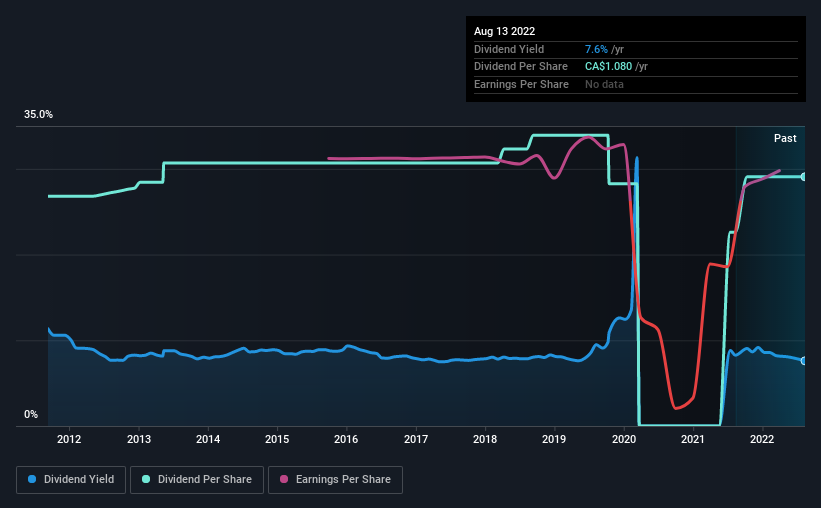Do These 3 Checks Before Buying SIR Royalty Income Fund (TSE:SRV.UN) For Its Upcoming Dividend
Regular readers will know that we love our dividends at Simply Wall St, which is why it's exciting to see SIR Royalty Income Fund (TSE:SRV.UN) is about to trade ex-dividend in the next 2 days. The ex-dividend date occurs one day before the record date which is the day on which shareholders need to be on the company's books in order to receive a dividend. The ex-dividend date is important as the process of settlement involves two full business days. So if you miss that date, you would not show up on the company's books on the record date. This means that investors who purchase SIR Royalty Income Fund's shares on or after the 17th of August will not receive the dividend, which will be paid on the 31st of August.
The company's next dividend payment will be CA$0.09 per share, and in the last 12 months, the company paid a total of CA$1.08 per share. Looking at the last 12 months of distributions, SIR Royalty Income Fund has a trailing yield of approximately 7.6% on its current stock price of CA$14.2. Dividends are a major contributor to investment returns for long term holders, but only if the dividend continues to be paid. As a result, readers should always check whether SIR Royalty Income Fund has been able to grow its dividends, or if the dividend might be cut.
View our latest analysis for SIR Royalty Income Fund
Dividends are usually paid out of company profits, so if a company pays out more than it earned then its dividend is usually at greater risk of being cut. Last year, SIR Royalty Income Fund paid out 95% of its income as dividends, which is above a level that we're comfortable with, especially if the company needs to reinvest in its business. A useful secondary check can be to evaluate whether SIR Royalty Income Fund generated enough free cash flow to afford its dividend. Over the last year, it paid out more than three-quarters (83%) of its free cash flow generated, which is fairly high and may be starting to limit reinvestment in the business.
It's good to see that while SIR Royalty Income Fund's dividends were not well covered by profits, at least they are affordable from a cash perspective. Still, if the company continues paying out such a high percentage of its profits, the dividend could be at risk if business turns sour.
Click here to see how much of its profit SIR Royalty Income Fund paid out over the last 12 months.
Have Earnings And Dividends Been Growing?
Businesses with shrinking earnings are tricky from a dividend perspective. If earnings decline and the company is forced to cut its dividend, investors could watch the value of their investment go up in smoke. With that in mind, we're discomforted by SIR Royalty Income Fund's 6.3% per annum decline in earnings in the past five years. Ultimately, when earnings per share decline, the size of the pie from which dividends can be paid, shrinks.
Many investors will assess a company's dividend performance by evaluating how much the dividend payments have changed over time. In the past 10 years, SIR Royalty Income Fund has increased its dividend at approximately 0.8% a year on average.
Final Takeaway
Has SIR Royalty Income Fund got what it takes to maintain its dividend payments? Earnings per share have been shrinking in recent times. Additionally, SIR Royalty Income Fund is paying out quite a high percentage of its earnings, and more than half its cash flow, so it's hard to evaluate whether the company is reinvesting enough in its business to improve its situation. With the way things are shaping up from a dividend perspective, we'd be inclined to steer clear of SIR Royalty Income Fund.
Although, if you're still interested in SIR Royalty Income Fund and want to know more, you'll find it very useful to know what risks this stock faces. Every company has risks, and we've spotted 2 warning signs for SIR Royalty Income Fund you should know about.
Generally, we wouldn't recommend just buying the first dividend stock you see. Here's a curated list of interesting stocks that are strong dividend payers.
Have feedback on this article? Concerned about the content? Get in touch with us directly. Alternatively, email editorial-team (at) simplywallst.com.
This article by Simply Wall St is general in nature. We provide commentary based on historical data and analyst forecasts only using an unbiased methodology and our articles are not intended to be financial advice. It does not constitute a recommendation to buy or sell any stock, and does not take account of your objectives, or your financial situation. We aim to bring you long-term focused analysis driven by fundamental data. Note that our analysis may not factor in the latest price-sensitive company announcements or qualitative material. Simply Wall St has no position in any stocks mentioned.
Join A Paid User Research Session
You’ll receive a US$30 Amazon Gift card for 1 hour of your time while helping us build better investing tools for the individual investors like yourself. Sign up here

 Yahoo Finance
Yahoo Finance 
